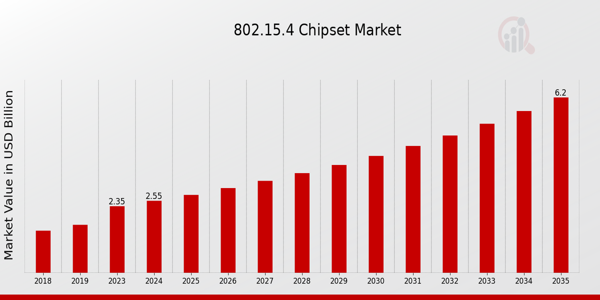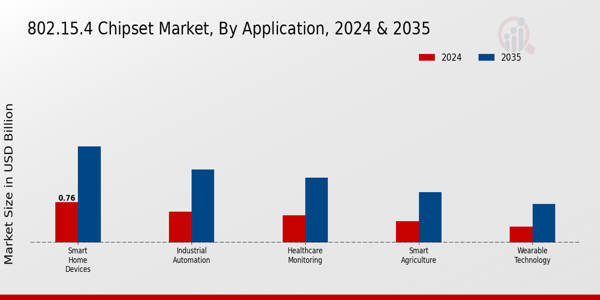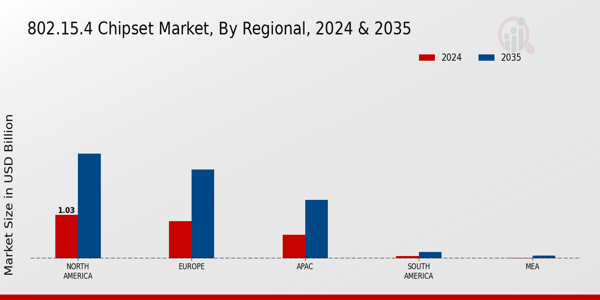802.15.4 Chipset Market Overview
As per MRFR analysis, the 802.15.4 Chipset Market Size was estimated at 2.35 (USD Billion) in 2023. The 802.15.4 Chipset Industry is expected to grow from 2.55 (USD Billion) in 2024 to 6.2 (USD Billion) by 2035. The 802.15.4 Chipset Market CAGR (growth rate) is expected to be around 8.42% during the forecast period (2025 - 2035).
Key 802.15.4 Chipset Market Trends Highlighted
The Global 802.15.4 Chipset Market is witnessing significant growth driven by the increasing demand for low-power wireless communication solutions. With the rise of Internet of Things (IoT) applications, including smart homes and industrial automation, the need for robust, energy-efficient chipsets has surged. The key market drivers include the growing adoption of smart devices, along with the need for reliable wireless communication standards that support a diverse range of applications. Manufacturers are responding by enhancing the capabilities of 802.15.4 chipsets, focusing on improving data rates and range, which plays an essential role in expanding their market presence.
There are numerous opportunities to be explored within this market, particularly in emerging regions where IoT adoption is rapidly evolving. Companies can tap into sectors such as healthcare, agriculture, and smart cities, where improved wireless communication technologies can provide significant benefits. Additionally, the integration of 802.15.4 with other wireless technologies presents opportunities for product innovation and the development of hybrid solutions that cater to diverse client needs. As industries seek more efficient communication methods, there will be a rising demand for these chipsets, unlocking new avenues for growth.
Recent trends indicate a shift towards the integration of security features and interoperability in chipsets. As concerns surrounding data privacy and protection increase, manufacturers are focusing on embedding advanced security protocols within their chipsets. This trend is critical for building trust and reliability among users, particularly in sectors where sensitive data is transmitted. The development of multi-protocol support within chipsets is also becoming a key focus, enabling devices to communicate seamlessly across various platforms. These shifts illustrate the ongoing innovation in the market, reflecting the dynamic nature of technology and the continuous need to meet evolving consumer demands.

Source: Primary Research, Secondary Research, MRFR Database and Analyst Review
802.15.4 Chipset Market Drivers
Increasing Demand for IoT Applications
The growing adoption of the Internet of Things (IoT) across various sectors is one of the key drivers propelling the 802.15.4 Chipset Market Industry. As devices become more interconnected, the need for reliable and low-power communication technologies has surged. The 802.15.4 protocol is particularly suited for IoT applications because it facilitates low-data-rate, low-power wireless communication. This is essential for devices that require extended battery life, such as sensors and smart home devices. The rise in smart cities, smart homes, and industrial automation is significantly boosting the demand for 802.15.4 chipsets as manufacturers strive to provide solutions that meet the needs of a connected world. Various industries, including healthcare, automotive, and consumer electronics, are increasingly integrating IoT capabilities, driving further demand for this technology. Additionally, the development of new IoT standards and frameworks that leverage 802.15.4 technology enhances its attractiveness to developers and engineers.
Growing Automation in Industrial Applications
Automation in industrial applications is fueling the growth of the 802.15.4 Chipset Market Industry. As industries increasingly adopt smart technologies and automation solutions, the need for robust and efficient communication protocols is crucial. The 802.15.4 protocol is specifically advantageous due to its energy efficiency and reliability, making it ideal for monitoring and controlling industrial processes.
Support for Smart Home Technologies
The rise of smart home technologies is significantly contributing to the expansion of the 802.15.4 Chipset Market Industry. Increasing consumer interest in home automation, security systems, and energy management solutions is driving the demand for 802.15.4 chipsets, which enable seamless communication between smart devices.
802.15.4 Chipset Market Segment Insights:
802.15.4 Chipset Market Application Insights
The 802.15.4 Chipset Market, particularly in the Application segment, presents considerable growth and segmentation opportunities. By 2024, the overall market was valued at approximately 2.55 USD Billion and is poised to reach 6.2 USD Billion by 2035, showcasing a robust upward trajectory. Within this segment, several applications play a pivotal role in shaping market dynamics. Smart Home Devices are particularly significant, with an estimated value of 0.76 USD Billion in 2024, which is expected to rise to 1.82 USD Billion by 2035, indicating a strong consumer shift towards IoT-enabled home automation. These devices dominate the market due to increasing consumer demand for convenience and energy efficiency. Following closely, Industrial Automation valued at 0.58 USD Billion in 2024 and anticipated to grow to 1.38 USD Billion in 2035, underscores the importance of real-time monitoring and process optimization in manufacturing processes, driven by the need for reduced operational costs and enhanced productivity.
Healthcare Monitoring is also a crucial application in this segment, valued at 0.51 USD Billion in 2024 and projected to climb to 1.23 USD Billion by 2035. The growth in this area is attributed to the increasing adoption of remote patient monitoring solutions, which foster enhanced patient care and management. Smart Agriculture, initially valued at 0.4 USD Billion in 2024 and expected to reach 0.95 USD Billion by 2035, highlights a rising trend towards precision farming. This application focuses on utilizing connected technologies to improve crop yields and enhance resource management, which is increasingly vital as global population pressures mount. Lastly, the Wearable Technology segment accounted for 0.3 USD Billion in 2024, with expectations of reaching 0.73 USD Billion by 2035. The growth in this sector reflects increased health consciousness and the rising trend of personal fitness and health tracking.
In summary, the diverse applications of the 802.15.4 Chipset Market, including Smart Home Devices, Industrial Automation, Healthcare Monitoring, Smart Agriculture, and Wearable Technology, each contribute significantly to the overall market landscape. The substantial revenue projections across these applications reveal a robust commitment to adopting 802.15.4 technology across various industries, driven by the demand for connectivity, efficiency, and smart solutions. The 802.15.4 Chipset Market revenue growth presents a promising horizon, reinforced by continuous advancements and integration into everyday life.

Source: Primary Research, Secondary Research, MRFR Database and Analyst Review
802.15.4 Chipset Market End Use Insights
The 802.15.4 Chipset Market, showcases a diverse range of end-use applications that drive its growth. The Consumer Electronics segment is prominent, catering to the increasing demand for home automation and smart devices, reflecting a significant shift in consumer behavior towards tech-savvy solutions. Meanwhile, the Healthcare sector utilizes these chipsets for essential applications such as remote monitoring, enhancing patient management and reducing healthcare costs. In the Industrial domain, the adoption of 802.15.4 chipsets supports efficient operations through robust industrial automation and real-time data analysis, which are critical for maximizing productivity. The Automotive industry also plays a crucial role, harnessing the capabilities of this technology for vehicle-to-everything (V2X) communication, aligning with the rising trends towards intelligent transportation systems. The combined influence of these sectors contributes to the steady growth of the market, emphasizing the importance of 802.15.4 Chipset Market segmentation in understanding industry dynamics and opportunities. The insights derived from 802.15.4 Chipset Market data highlight how these end uses align with broader technological advancements and consumer needs, ultimately driving the market's evolution through 2035.
802.15.4 Chipset Market Connectivity Type Insights
The 802.15.4 Chipset Market, Mesh Networking is particularly significant due to its ability to enhance communication across large areas by connecting multiple devices seamlessly, making it ideal for applications in smart homes and industrial automation. Point-to-multipoint connections are also vital as they enable a single source to communicate with multiple devices, offering versatility in various networking configurations. Although Point-to-Point connections offer straightforward communication pathways, their limited reach restricts their widespread application compared to the other types. The market growth is further fueled by increasing demand for IoT applications, smart city initiatives, and advancements in wireless technology, while challenges such as interoperability and potential security issues remain. As the 802.15.4 Chipset Market data highlights, understanding these connectivity types is crucial for stakeholders aiming to leverage the full potential of this expanding industry, which is expected to reach 6.2 billion USD by 2035, indicating robust demand and promising growth.
802.15.4 Chipset Market Component Type Insights
The 802.15.4 Chipset Market is expected to this market, the Component Type segment includes important categories such as Transceivers, Microcontrollers, Software Protocols and Power Amplifiers. Transceivers play a crucial role in enabling wireless communication, while Microcontrollers are essential for processing and managing data flow, making them significant drivers of innovation in IoT applications. Software Protocols assure effective communication and interoperability among devices, hence enhancing market potential. Power Amplifiers are vital for boosting transmission signals, making them critical in applications requiring extended range and reliability. The market is witnessing notable trends driven by rising demand for smart home devices, industrial automation, and wireless connectivity solutions, which create opportunities for expansion in this space. Overall, the 802.15.4 Chipset Market segmentation suggests a robust growth trajectory, supported by the essential functions of each component type, showcasing their importance in a rapidly evolving technological landscape.
802.15.4 Chipset Market Regional Insights
The Regional segment of the 802.15.4 Chipset Market reveals significant growth opportunities across various regions. North America leads the market with an expected valuation of 1.03 USD Billion in 2024, growing to 2.47 USD Billion by 2035, indicating its dominance due to extensive adoption of smart home devices and industrial automation. Europe follows closely, projected to rise from 0.88 USD Billion in 2024 to 2.09 USD Billion in 2035, driven by increasing investments in IoT solutions. The Asia-Pacific (APAC) region, valued at 0.56 USD Billion in 2024 and expected to reach 1.38 USD Billion by 2035, showcases significant potential largely attributed to growing connectivity demands. South America and the Middle East Africa (MEA) show comparatively lower valuations, with South America estimated at 0.06 USD Billion in 2024 and MEA at 0.02 USD Billion, but these regions harbor unique growth potential driven by increasing technology adoption. Overall, the 802.15.4 Chipset Market data reflects varied demand and highlights North America and Europe as major contributors to market revenue, while APAC’s market growth is fueled by expanding infrastructure and innovative solutions.

Source: Primary Research, Secondary Research, MRFR Database and Analyst Review
802.15.4 Chipset Market Key Players and Competitive Insights:
The 802.15.4 Chipset Market is characterized by rapid evolution and a highly competitive landscape, driven by the rising demand for wireless communication technologies, particularly in the Internet of Things (IoT) sector. Key players in this market are constantly innovating to enhance the performance and efficiency of their chipsets to meet the needs of diversified applications, ranging from home automation to industrial automation. The market dynamics are significant, with numerous entrants providing a variety of solutions, which intensifies competition. As the market progresses, factors such as technological advancements, strategic partnerships, and economies of scale play pivotal roles in determining the competitiveness of companies involved in the production of 802.15.4 chipsets.
Atmel has made considerable strides in the 802.15.4 Chipset Market, establishing a robust presence through innovative product offerings that cater to the needs of modern applications. The company is recognized for its commitment to quality and reliability, producing chipsets that excel in energy efficiency and connectivity options. Atmel's strong focus on research and development has enabled it to stay ahead of competitors by continuously introducing state-of-the-art solutions that maximize performance while ensuring low power consumption. This strategic emphasis on enhancing product capabilities, combined with a well-established distribution network, allows Atmel to effectively address customer demands and solidify its position within the market.
Dialog Semiconductor is another noteworthy player in the 802.15.4 Chipset Market, known for its advanced technological solutions and strong innovation pipeline. The company excels in offering chipsets that are optimized for low power consumption, which is essential for battery-operated devices widely used in IoT applications. Dialog Semiconductor's ability to integrate high performance with cost efficiency has set it apart from competitors, providing customers with capable solutions that meet both technical and budgetary requirements. Furthermore, Dialog Semiconductor has established strategic alliances with key stakeholders in the industry, enhancing its market visibility and distribution capabilities. Through these efforts, the company continues to strengthen its position and appeal in the fast-growing sector of wireless communication technologies.
Key Companies in the 802.15.4 Chipset Market Include:
- Atmel
- Dialog Semiconductor
- Maxim Integrated
- Semtech
- Nordic Semiconductor
- Renesas Electronics
- NXP Semiconductors
- On Semiconductor
- Microchip Technology
- Analog Devices
- Silicon Labs
- Infineon Technologies
- Cypress Semiconductor
- STMicroelectronics
- Texas Instruments
802.15.4 Chipset Industry Developments
Recent developments in the 802.15.4 Chipset Market are marked by significant advancements and strategic maneuvers by key industry players. Companies such as Atmel, Dialog Semiconductor, and Microchip Technology have been focusing on product innovation to enhance their competitive edge, aiming at integration with IoT applications. Notably, the market is witnessing growing demand driven by smart home devices and industrial automation, prompting these firms to invest in next-generation chipsets. Current affairs indicate substantial growth prospects, with major companies like NXP Semiconductors and Texas Instruments expanding their product portfolios to cater to evolving consumer needs.
Furthermore, the market dynamics are influenced by mergers and acquisitions as companies seek to leverage synergies for technological advancement. For example, Infineon Technologies and STMicroelectronics are exploring strategic collaborations to enhance their market offerings, while Silicon Labs continues to expand its footprint through targeted acquisitions. These activities highlight a robust competitive landscape, significantly impacting market valuation and positioning of the 802.15.4 chipset technology, paving the way for further innovation and growth opportunities within the sector.
802.15.4 Chipset Market Segmentation Insights
-
15.4 Chipset Market Application Outlook
- Smart Home Devices
- Industrial Automation
- Healthcare Monitoring
- Smart Agriculture
- Wearable Technology
-
15.4 Chipset Market End Use Outlook
- Consumer Electronics
- Healthcare
- Industrial
- Automotive
-
15.4 Chipset Market Connectivity Type Outlook
- Point-to-Point
- Point-to-Multipoint
- Mesh Networking
-
15.4 Chipset Market Component Type Outlook
- Transceivers
- Microcontrollers
- Software Protocols
- Power Amplifiers
-
15.4 Chipset Market Regional Outlook
- North America
- Europe
- South America
- Asia Pacific
- Middle East and Africa
802.15.4 Chipset Market Report Scope
|
Report Attribute/Metric
|
Details
|
|
Market Size 2023
|
2.35 (USD Billion)
|
|
Market Size 2024
|
2.55 (USD Billion)
|
|
Market Size 2035
|
6.2 (USD Billion)
|
|
Compound Annual Growth Rate (CAGR)
|
8.42% (2025 - 2035)
|
|
Report Coverage
|
Revenue Forecast, Competitive Landscape, Growth Factors, and Trends
|
|
Base Year
|
2024
|
|
Market Forecast Period
|
2025 - 2035
|
|
Historical Data
|
2019 - 2024
|
|
Market Forecast Units
|
USD Billion
|
|
Key Companies Profiled
|
Atmel, Dialog Semiconductor, Maxim Integrated, Semtech, Nordic Semiconductor, Renesas Electronics, NXP Semiconductors, On Semiconductor, Microchip Technology, Analog Devices, Silicon Labs, Infineon Technologies, Cypress Semiconductor, STMicroelectronics, Texas Instruments
|
|
Segments Covered
|
Application, End Use, Connectivity Type, Component Type, Regional
|
|
Key Market Opportunities
|
Growing IoT adoption,Smart home devices,Industrial automation expansion,Energy-efficient solutions,Enhanced mesh networking capabilities |
|
Key Market Dynamics
|
Increasing IoT deployment,Demand for low-power devices,Growth in smart home solutions,Expanding industrial automation applications,Rising adoption of wireless sensor networks |
|
Countries Covered
|
North America, Europe, APAC, South America, MEA
|
Frequently Asked Questions (FAQ) :
The 802.15.4 Chipset Market is expected to be valued at 2.55 USD Billion in 2024.
By 2035, the market is projected to reach 6.2 USD Billion.
The market is expected to grow at a CAGR of 8.42% from 2025 to 2035.
North America is expected to lead with a market size of 2.47 USD Billion by 2035.
The market for Smart Home Devices is expected to reach 1.82 USD Billion by 2035.
The Healthcare Monitoring segment is anticipated to grow significantly, reaching 1.23 USD Billion by 2035.
Major players include Atmel, Dialog Semiconductor, Maxim Integrated, and NXP Semiconductors among others.
The Industrial Automation segment is projected to reach 1.38 USD Billion by 2035.
The APAC region is projected to have a market value of 1.38 USD Billion in 2035.
The Wearable Technology segment is expected to reach 0.73 USD Billion by 2035.
















